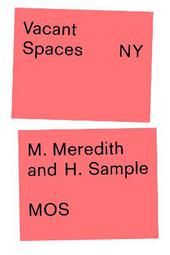
|
Vacant Spaces NY
Paperback / softback
Main Details
| Title |
Vacant Spaces NY
|
| Authors and Contributors |
By (author) Michael Meredith
|
|
By (author) Sample
|
|
By (author) MOS
|
| Physical Properties |
| Format:Paperback / softback | | Pages:608 | | Dimensions(mm): Height 228,Width 152 |
|
| Category/Genre | Architecture
Individual architects and architectural firms |
|---|
| ISBN/Barcode |
9781948765992
|
| Classifications | Dewey:724/.6097471 |
|---|
| Audience | |
|---|
|
Publishing Details |
| Publisher |
Actar Publishers
|
| Imprint |
Actar Publishers
|
| Publication Date |
21 December 2021 |
| Publication Country |
United States
|
Description
Vacant Spaces NY begins gathering the incomplete data available and documenting vacant spaces in New York City. Organized from large to small, general to specific, vacancy in the United States to case studies of specific vacancies in Manhattan, Michael Meredith, Hilary Sample, and their architecture studio MOS imagine possibilities for repurposing current vacant spaces in New York City. This project began by walking around our neighborhood noticing empty storefronts. Once we saw them, they were everywhere. They followed us, appearing quietly throughout New York City. Many with no signage, no "for rent," no "coming soon." Usually empty, sometimes dusty, sometimes with brown paper covering the glass. Now, vacancy has only increased. In the densest city in the United States. During a housing crisis. Throughout a pandemic. The quantity of vacant spaces is anyone's best guess. It's only partially documented. They hide in plain sight. Vacant Spaces NY is organized from large to small, general to specific. It begins by looking at vacancy within the United States and continues down to each Manhattan neighborhood, where we zoom into specific vacant spaces, where we have provided as case studies that imagine some possibilities for transforming current vacant spaces into housing or social services. There is also a section on Covid 19, which infiltrated New York during our research. As a whole, this document is not meant to provide specific solutions. The data is incomplete. Case studies are limited. We are not policy experts or data analysts or urban planners. Instead, it is simply meant to show something we have taken for granted, vacant spaces, taking part in a collective process of imagining a better city.
Author Biography
Michael Meredith, along with Hilary Sample, is a principal of MOS, an internationally recognized architecture practice based in New York, and Professor at Princeton University School of Architecture. Hilary Sample is the IDC Professor of Housing Design and Sequence Director of the Core Architecture Studios at GSAPP, and co-founder of the New York-based architecture and design studio MOS.
Reviews"Meredith and Sample visualize alternate futures: street-level stores, once catering to luxury products and experiences, become collective and affordable apartments, community centers, libraries, and soup kitchens. Acknowledging the large-scale, structural problems of financialized real estate while proposing small-scale interventions, the designers don't pretend to have all the solutions, but rather aspire to take part in "a collective process of imagining a better city."" --Urban Omnibus "What to do with New York's empty storefronts? HILARY SAMPLE, FAIA, and Michael Meredith, AIA--co-founders of the local firm MOS--tackle the question with vigor, painstakingly documenting long-discussed storefronts and proposing a suite of possible solutions aimed at enhancing the city's community and urban fabric." --Architect, The Journal of the American Institute of Architects "...the book is a critique of New York City's rampant, zoning-enabled, developer-driven, tear-down-and-build-up mentality, instead of saying that there are enough buildings but their spaces need to be filled in in better, more equitable ways. Though out of step with "big real estate's" insatiable thirst for luxury housing, it's an approach that is in step with the times and will most likely see more and more support as time marches on." --John Hill, A Daily Dose of Architecture "Informative, thought-provoking, and a unique contribution to our on-going regional and national discussions with reference to urban planning and reversing urban decay, "Vacant Spaces NY" is especially and unreservedly recommended additions to professional, governmental, college, and university library Urban & Land Use Planning and Contemporary Architecture collections. It should be noted for the personal reading lists of architects, city planners, urban renewal activists, students, academics, and non-specialist general readers with an interest in the subject that "Vacant Spaces NY" is also readily available in a digital book format." --Midwest Book Review
|